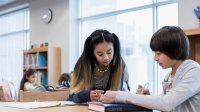Promoting Self-Direction Through Better Feedback
When students get the right feedback at the right time, they move closer to becoming independent learners.
Your content has been saved!
Go to My Saved Content.Every teacher desires students to become their own teachers over time. The idea that students develop self-direction—independent of needing immediate support from teachers—and the ability to solve their own problems is a recurring dream of teachers. But how do we develop independent, self-directed learners when we have so many other demands as educators? Interestingly, one of the most powerful strategies we have at our disposal to build student independence in their learning is through our approach to feedback.
Feedback has the potential to double the rate of learning. A critical aspect of feedback is the quality of its delivery and use by teachers and students. The quality of feedback is increased when students are clear on expectations, when teachers take a coaching role, and when feedback is provided to students in class when they are learning information. Each of these quality feedback criteria, along with related strategies, are shown below.
Clarity
Ensure that students are clear on the expectations of success for varying levels of performance. Students need to know the difference between an A-level and a B-level paper. Moreover, they need to know what the key criteria are that make those pieces successful. Finally, the peer-to-peer influence of giving, receiving, and using feedback cannot be overstated. We need to ensure that students give each other accurate feedback. Starting with clarity is a surefire way to make feedback a mutual enterprise between students and teachers.
Explore exemplars: Provide students with work samples that incorporate a range of performance levels. Ask students to rank the work samples and share their reasons for ranking each one. Next, share your ranking and rationale and discuss the similarities and differences between your thinking and the students’.
Co-construct goals and criteria for success: Rubrics are often lists of answers students need to learn (e.g., add fractions with common denominators). In lieu of giving them the answers, present students with questions (e.g., how do we add fractions with the same common denominators?).
Reflect on progress: Use protocols that enable students to reflect on their growth over time. One powerful example is the “I used to think” protocol.
Teachers as Coaches
Walt Whitman (and Ted Lasso) stated, “be curious, not judgmental.” Or as Maria Konnikova shared in her book The Biggest Bluff, engage in “less certainty, more inquiry.” We can take a proactive inquiry stance by simply asking questions early in the guided practice and independent work time in the class. Engage with inquiry a little longer than you normally would.
Here are three questions to use routinely in your roving around the classroom:
1. The Clarity Question: Where do you need to go next in your learning?
2. The Strategy Question: How will you get to the next place in your learning?
3. The Learning Question: How will you know if your actions worked toward your goal?
Initiating Feedback in Class
Feedback is most effective when it is provided when students need it, and that’s in the learning environment with their teacher and peers. To maximize the impact of feedback, consider the following daily actions.
Use entrance tickets: Instead of fretting about what happened after the fact, gain that information at the beginning and during class so that you can respond. Entrance tickets may include a question prompt to prime prior knowledge and a simple think-pair-share with the entire class.
Use the just-in-time fishbowl: Stop the class in the middle of guided practice or independent practice and select one student to come to the middle of the classroom. Ask students to circle around while you have a feedback conversation with the selected student. A few ways for students to feel more comfortable in engaging with feedback in public is to prepare them before the exercise by going through a few of the questions you will ask. Model the process first with you being the person in the fishbowl and students asking you questions, and then ask students to create collective norms to make sure that everyone feels safe in this process. Next, ask students to reflect on the process for giving and receiving feedback.
Use prior-to-exit tickets: Instead of ending class without knowing what students learned, gain that information two-thirds of the way through class, and enable students to support each other in meeting expectations of the learning goals.
The aforementioned criteria illustrate a theme that self-direction of learning is forged through the mutual responsibility of learning between students and teachers. When students and teachers work together to gain clarity, to engage in a coaching relationship to solve problems, and to work together in the moment to make course corrections, students develop confidence in their own learning and realize that they are not alone in their learning.
This “we-do” approach actually leads to a greater sense of independence. The challenge for us as teachers is to stay in the we-do phase of learning as long as possible. We must embrace the idea that building independence in learning is much less about the gradual release of responsibility of learning to students and more associated with the shared responsibility of improving learning together.
